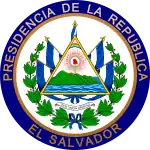Armando Calderón Sol | |
|---|---|
 | |
| 38th President of El Salvador | |
| In office 1 June 1994 – 1 June 1999 | |
| Vice President | Enrique Borgo Bustamante |
| Preceded by | Alfredo Cristiani |
| Succeeded by | Francisco Flores |
| Mayor of San Salvador | |
| In office 1 May 1988 – 1 May 1994 | |
| Preceded by | José Antonio Morales Ehrlich |
| Succeeded by | Mario Valiente |
| Personal details | |
| Born | 24 June 1948 San Salvador, El Salvador |
| Died | 9 October 2017 (aged 69) Houston, Texas, U.S. |
| Cause of death | Lung cancer |
| Political party | ARENA |
| Spouse | Elizabeth Aguirre de Calderón |
| Relatives | Milena Calderón Sol de Escalón (sister) |
| Profession | politician |
Armando Calderón Sol (24 June 1948 – 9 October 2017) was President of El Salvador from 1 June 1994, to 1 June 1999, representing the Nationalist Republican Alliance. He was the first president elected in El Salvador after twelve years of civil war.[1]
Early life and education
Born in San Salvador in 1948,[2] Calderón attended the exclusive primary and secondary school Colegio Externado San José, graduating in 1966. In 1977, Calderón received a graduate degree in Jurisprudence and Social Sciences from Universidad Nacional de El Salvador. He was a lawyer, a businessman, and one of the founders of Nationalist Republican Alliance (ARENA), in September 1981.
Political career
Mayor of San Salvador
As Mayor of San Salvador from 1988 to 1994 he built the Monument to "Hermano Lejano" at the end of the Comalapa Highway and Blvd. Los Proceres and also built the bust monuments along the Proceres Boulevard. He promoted physical exercise and initiated a cyclist's circuit in the San Jacinto neighbourhood on Avenida Cuba.
President of El Salvador

When he ran for president in 1994 he won the presidential office during the runoff elections against the leftist candidate, Dr. Ruben Zamora from the CD-FMLN coalition.
Calderón is acknowledged in the press for restoring the status-quo after the civil war, which ended on 16 January 1992. He advocated the privatization of state owned telephone companies and pension funds to stimulate the economy and modernize the country's infrastructure. He is also known for having promoted reforms to make El Salvador competitive in the maquila industry, removing trade barriers across the board, including removing protection for local agriculture. This had the unintended consequence of disrupting small scale farming, driving migration to larger cities (and abroad, especially the U.S.) and creating a cheaper labour supply for the maquilas.
Calderón is also credited with the integration of former guerrillas combatants back into civilian life. He is also known for having initiated the privatization of the telecommunications company ANTEL and the electrical works company, CAESS (Compañía de Alumbrado Electrico de San Salvador), public hospitals and pension funds. He followed president Alfredo Cristiani's neoliberal approach, and his structural adjustment programs.
Death
Calderón Sol died on 9 October 2017 of lung cancer[3] at a Houston, Texas, hospital at the age of 68.[4][5]
References
- ↑ Sam Roberts (13 October 2017). "Leader of El Salvador after its civil war". Globe and Mail. New York Times News Service. p. S9.
- ↑ Clements, John (5 October 1998). "Clements' Encyclopedia of World Governments". Political Research, Incorporated – via Google Books.
- ↑ "Políticos reaccionan en redes sociales ante muerte de Armando Calderón Sol". AP. Retrieved 9 October 2017.
- ↑ "Noticias de Costa Rica". La Nación, Grupo Nación.
- ↑ "Fallece expresidente Armando Calderón Sol". www.laprensagrafica.com.
External links
- https://web.archive.org/web/20030207070924/http://archive.laprensa.com.sv/19990703/
- Extended biography of Armando Calderón Sol at Fundación CIDOB
